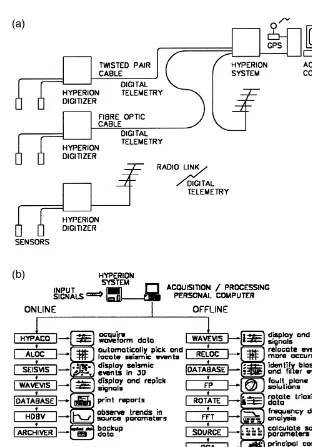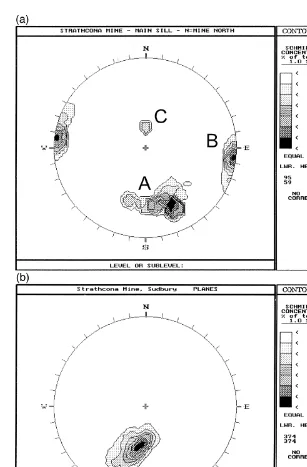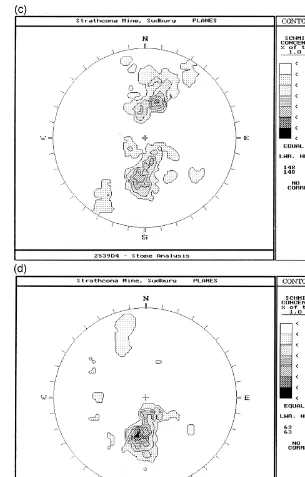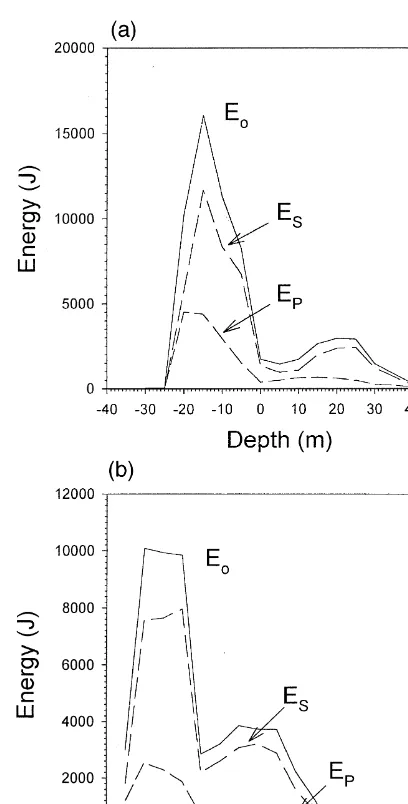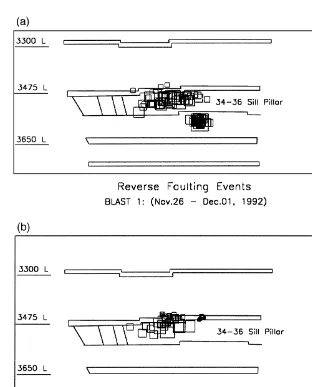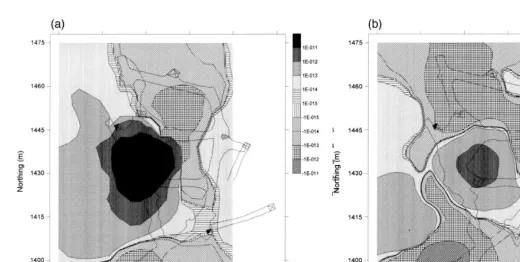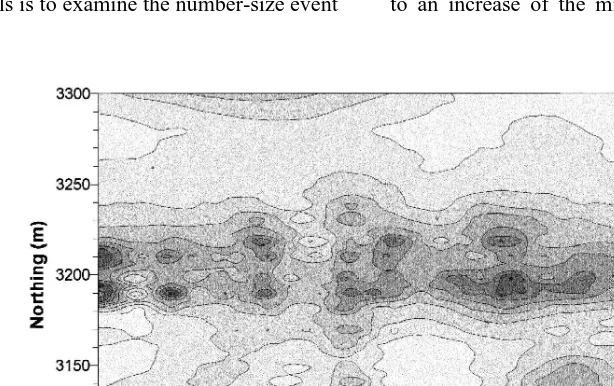www.elsevier.nlrlocaterjappgeo
Recent advances in seismic monitoring technology at
Canadian mines
Theodore I. Urbancic
), Cezar-Ioan Trifu
Engineering Seismology Group Canada, 1 Hyperion Ct., Kingston, Ontario, Canada K7K 7G3
Received 23 April 1999; accepted 14 September 2000
Abstract
We provide an overview of the current status of seismic monitoring instrumentation employed in Canadian underground mines. Based on several case studies, we outline how passive seismic monitoring techniques are being used to evaluate fractures and stress conditions associated with ore extraction at depth. It is shown that induced microseismicity allows for the remote monitoring of active fractures, delineating modes of failure with advancing excavation fronts, and identifying variations in principal stress orientations during sequential stages of mining. Advances into the characterization of excavation zone of influence through deformation state analysis and the use of seismic hazard analysis to evaluate the potential for ground instability are also discussed.q2000 Elsevier Science B.V. All rights reserved.
Keywords: Seismic monitoring; Microseismicity; Canadian mines
1. Introduction
Mining-induced seismicity is directly related to the interaction of mine excavations and geological structures with regional and local stress fields. Seis-mic energy is released when a frictional instability occurs on pre-existing geological structures, or when new fractures are formed. This has, in extreme cir-cumstances, taken the form of rockbursts, which can potentially affect personal safety and mine integrity. As mining continues to greater depths in the future, the impact of rockbursts may have substantial
eco-)Corresponding author.
Ž .
E-mail address: [email protected] T.I. Urbancic .
nomical implications. Therefore, understanding the mechanics of rockburst occurrence is critical for the design of effective and efficient mining operations.
Over the last decade, impressive progress in this area of study has occurred primarily as a result of advances in seismic instrumentation. The transition to digital high frequency full waveform data acquisi-tion systems with increased dynamic range, has al-lowed for the monitoring of microseismicity in addi-tion to rockbursts. As such, microseismic events, which are defined as events with magnitudes less than zero and comprise the largest percentage of seismic observations at a mine site, can now be used to provide information on the mechanics of strain energy accumulation due to mining and the changing rock mass conditions leading to the generation of
Ž .
rockbursts Board, 1994 .
0926-9851r00r$ - see front matterq2000 Elsevier Science B.V. All rights reserved.
Ž .
The availability of waveform records has resulted in the application of several techniques traditionally employed in earthquakes studies, which provided insight into the failure mechanism, including possi-ble fracture and stress orientations, and character-istics of the source, such as source strength, the extent of slip, energy and stress release. As a result, a better understanding of seismic source
inhomo-Ž .
geneity McGarr, 1991 and source scaling behaviour ŽGibowicz, 1995. as related to mining has been achieved.
In this paper, we illustrate the development of seismic instrumentation and how seismological tech-niques have been used in Canadian mines over the past few years in order to characterize the rock mass conditions in the presence of excavations. Several
Ž . Ž .
case studies are presented on how these techniques have been employed to map active structures, iden-tify modes of failure with advancing mining, and characterize stress variations during sequential stages of excavation. Furthermore, we outline how micro-seismicity can be used to determine the extent of excavation influence and assess the seismic hazard associated with underground mining operations.
2. Instrumentation
In the past few years, advances in off-the-shelf hardware and software components have stimulated the development of readily available, reliable, and cost effective full-waveform seismic monitoring equipment. Moreover, on-line seismic analysis rou-tines have provided mines with the capability to record and process event occurrence rates that may exceed 100 events per day. As such, seismology has become an accessible tool for remote on-going char-acterization of rock mass conditions under the influ-ence of mining. Further, the installation and opera-tion of seismic monitoring equipment have as a result been widely embraced by the mining commu-nity.
As shown in Fig. 1a, seismic monitoring installa-tions are typically configured using twisted pair ca-ble, fiber optics, radio telemetry, or a hybrid combi-nation of the above. Digitization rates are up to 40 kHz with 16-bit resolution, allowing for the effective recording of events with magnitudes down to y3. Acquisition units employ complex trigger logic to reduce mis-triggers due to mine noise. Installed sen-sors are typically either uniaxial or triaxial ac-celerometers; however, geophones are commonly used for surface installations. A Global Positioning
Ž .
System GPS is employed to time-link regional and local systems.
Fig. 1b illustrates, as an example, software for data acquisition and processing of mine induced seismicity. The software operates in a multi-tasking environment, such as Microsoft Windows ’98, en-abling various applications to run concurrently. Seis-mic parameters are stored in database structures, allowing for advanced filtering of records based on
user defined time, space and other parameter con-straints. Data visualization and plotting routines are also available for 3-D viewing of seismicity and source parameters in real-time.
3. Identification of active structures
In underground mines, geological structures of varying size can be activated by the presence of workings and their interaction with the localr re-gional stress fields. The location of these fractures is provided by the spatial distribution of seismic events. By assuming that shear is the dominant mode of failure, it is possible to use seismic waveform
infor-Ž .
mation, such as compressional wave P-wave first motions, to also define possible orientations of active
Ž .
fractures fault-plane solutions . The effectiveness of using the above approaches as a mapping tool can then be examined in the context of known geological
Ž .
structures Urbancic et al., 1993 .
In Fig. 2a, the distribution of poles to fractures is contoured on lower hemisphere equal area stere-onets, as determined from underground mapping at Strathcona mine, Sudbury, Canada. The spatial clus-tering of event locations suggests that the events tended to preferentially align themselves along one
Ž .
of the mapped structural sets Set A; Fig. 2b . This orientation is one of two outlined by using fault-plane
Ž .
solutions Fig. 2c , and corresponds to the orienta-tion obtained by assuming that these failures oc-curred under a single, relatively stable regional stress
Ž .
field Fig. 2d . Based on these observations, it is clear that mining induced microseismicity is associ-ated with pre-existing fractures, and that seismic analysis provides the means to remotely monitor active fractures throughout the mine.
4. Mechanisms of failure ahead of advancing min-ing fronts
The energy partition between the P-waves and Ž .
present in the seismic sources. Typically, the seismic energy release for P-waves is 20 to 30 times smaller
Ž
than that for S-waves Boatwright and Fletcher,
.
1984 . Conversely, the P-wave and S-wave energy release are approximately equal for tensile failure ŽSato, 1978 . As a result, by examining the energy.
Ž . Ž . Ž .
Fig. 2. Stereonet projections for Strathcona mine of the poles to the a mapped fractures, b spatial orientation of seismicity, c fault-plane Ž .
Ž . Fig. 2 continued .
ratio it may be possible to evaluate the types of Ž
failures occurring with progressive mining Urbancic .
and Young, 1993 .
In Fig. 3, the energy values vary strongly with position relative to an advancing excavation face at Strathcona mine. The largest total seismic energy
Ž . Ž . Fig. 3. Average total seismic energy EO, P-wave energy E ,P
Ž .
and S-wave energy ES values based on a 5-m moving window
Ž . Ž .
as a function of a depth above the excavation base and b ahead
Ž .
of the advancing excavation front north .
energy, suggesting that a large non-shear failure component exists, whereas events at distance from the excavation face appear to be enriched in S-wave relative to P-wave energy implying the presence of a dominant shear failure mechanism. Between these two extremes exists a transition zone where failures have varying proportions of shear and non-shear components.
Based on fault-plane solutions, different fracture Ž
sets were activated in the three zones Sets C, B, and .
A, respectively; Fig. 2 , defining a systematic pattern of fracture behaviour with advancing excavation. By accounting for the potential effects these features may have on continued mining in highly stressed rock masses at depth, it is expected that on-going mine design extraction methodologies could be fur-ther improved.
5. Stress changes associated with mining se-quences
In addition to defining the likely active fractures, fault-plane solutions provide information on the prin-cipal strain axes under which slip occurred. These
Ž . Ž .
axes are referred to as the pressure P , null B , Ž .
and tension T axes, and under certain conditions they can be directly related to the principal stress axes. To define variations in stress during several stages of a mining sequence, a stress inversion tech-nique can be employed, based on the principal strains, by assuming that at every stage of the sequence, the events occurred under a relatively stable stress field ŽGephart and Forsyth, 1984 ..
From the analysis of microseismicity associated with five stages of a panel extraction within a sill pillar at 1050 m depth in Lockerby mine, Sudbury, Ž . Canada, two types of events were observed, 1 reverse faulting events within the sill and just below
Ž . Ž .
the sill Fig. 4a and 2 normal faulting events at the
Ž .
top of the sill Fig. 4b . The principal stresses of the reverse faulting events for the five excavation stages in the sill remained relatively stable over the entire
Ž .
sequence Fig. 4c , namely for three blasting inter-vals and during the prerpost-mining periods, with s approximately sub-horizontal and trending
1
north–south, s sub-horizontal and trending east– 2
west, and s sub-vertical. This trend ofs differs by
3 1
approximately 908 from that determined for the re-Ž
gional s , trending east–west Sampson-Forsyth, 1
.
1994 . For the cluster below the sill, there is no change in the orientation of the induced stress field from the regional field. As with the reverse faulting, the stress field responsible for the normal faulting was found to be relatively stable over the entire
Ž .
vertical,s sub-horizontal and trending north–south, 2
s sub-horizontal and trending east–west. This ap-3
proach allows for the remote characterization of the dynamic behaviour of fractures based on the identi-fied stress field within the rock mass. As such, for fractures activated under quasi-stable stress condi-tions, this methodology further assists in mine ex-traction strategies.
6. Delineation of the excavation zone of influence
Focal mechanism data, contained within limited volumes throughout a seismically active region, can be used to determine the rate of deformation associ-ated with underground excavations. The method ap-plies nearest neighbourhood statistics to individual P and T axes, and assumes that the deformation in the
Ž . Ž . Ž .
Fig. 4. Longitudinal view looking north showing the distribution of a reverse and b normal faulting events for the first blast interval.
Ž . Ž . Ž .
Principal stress axes s1—open circles, s2—stars,s3—filled circles of the reverse c and normal d faulting events for the different
Ž . Ž . Ž . Ž .
extraction stages: pre-mining Pre , blast 1 B1a for events within the sill and B1b for those below , blast 2 B2 , blast 3 B3 , and
Ž .
Ž . Fig. 4 continued .
study volume acts similarly over the entire range of
Ž .
observed magnitudes Kostrov and Das, 1988 . To illustrate the potential of using deformation rate anal-ysis to outline the extent of excavation influence on the surrounding rock mass, the method was applied to microseismicity recorded following two
produc-Ž .
tion blasts stages 3 and 6; Fig. 5 of a sill pillar at about 900 m depth in Campbell mine, Balmertown,
Ž .
Canada Urbancic et al., 1997 .
In Fig. 6, the depth component of deformation rate is presented for both extraction stages. Follow-ing stage 3, the largest deformation rates, as ex-pected, occurred in the excavation volume. However,
Ž . Fig. 5. Distribution of seismicity in plan view at a mid-sill
Ž . Ž
height and b in cross-section for excavation stages 3 open
. Ž .
()
Urbancic,
C.-I.
Trifu
r
Journal
of
Applied
Geophysics
45
2000
225
–
237
233
y1 Ž . Ž . Ž . Ž .
Ž.
Fig.
6
continued
high rates were also observed outside the excavation, suggesting that the rock mass in the vicinity of the subsequent stage 6 excavation was already in a state of transformation. Similarly, following stage 6, high deformation rates were observed not only throughout the entire excavated volume, but also in the region of the subsequent stage 7 excavation. Interestingly, fol-lowing stage 7, a ground fall occurred 15 m west and parallel to the long wall of stage 6, suggesting that there may be a link between the observed deforma-tion rate and the occurrence of the ground fall. Future studies will be required to quantitatively es-tablish a relationship between deformation rates and actual strain rates within the rock mass.
7. Seismic hazard assessment
The evaluation of seismic hazard is based on estimating the probability of exceeding critical peak velocity or acceleration values over time. To meet this goal, several parameters have to be determined, including the expected maximum magnitude levels, failure mechanisms, and effect of attenuation on signals transmitted to various sensor sites under-ground. One approach for evaluating the maximum magnitude levels is to examine the number-size event
distribution in space and time. This can be achieved by combining both non-parametric and parametric
Ž statistics, based on nearest neighbourhoods Trifu
.
and Shumila, 1996 , in order to calculate event oc-currence rates at given magnitudes and the slope of
Ž .
the number-size distribution b-value .
To test the appropriateness of evaluating space– time variations in b-value for the purposes of seis-mic hazard assessment, the above approach was applied to a catalogue of microseismic events
Ž .
recorded at depth below 600 m within Strathcona mine, Sudbury, Canada, for 1 month prior to and 1 month following a moment magnitude 2.9 rockburst. Fig. 7 shows the space–time distribution of b-values in the northing direction. As seen, the magnitude 2.9 rockburst, which occurred at day 28, was preceded by a decrease in the b-value from 1.2–1.4 to 0.6–0.8 over a period of about 2–3 days. Similar results were obtained when using either easting or depth as a space co-ordinate. The relative errors in the evalua-tion of b-values were found to be about 10–15%.
Based on these observations, the decrease in b-value prior to the occurrence of a large magnitude earthquake is likely associated with a relative
in-Ž
crease in the effective stress see Trifu and Urbancic, .
1996 . Under increasing stress conditions, there is a tendency for the higher strength areas to fail, leading to an increase of the microseismic activity at
tively higher magnitudes. Since the method has the advantage of allowing for the estimation of the seis-micity parameters at every moment of time and each spatial location, it has the potential to be used to establish seismic hazard assessment maps in mines.
8. Conclusions
In the last decade, insight into mining induced seismicity, including the generation of rockbursts, has been expanded primarily through the develop-ment of high frequency data acquisition instrudevelop-menta- instrumenta-tion with increased dynamic range, and the adapta-tion of earthquake analysis techniques to this envi-ronment. This has allowed for smaller events, with magnitudes less than zero, to be routinely recorded and processed in mines. As a result, a better under-standing of the interaction between excavations, the regional stress field, and local structural geology has been achieved.
In this paper, we have provided examples of how different seismic techniques can be used at mine sites. These techniques include the identification of: Ž .1 active fractures through the use of space–time distribution in microseismicity and fault-plane
solu-Ž .
tions; 2 mode of failure with respect to the excava-tion front by employing S- to P-wave energy ratios;
Ž .
and 3 local principal stress orientations in the vicinity of openings using stress inversion of princi-pal strain axes. Applications of these studies to mining operations range from on-going design of blast and extraction procedures to defining support requirements.
The dilemma faced by mine operators is how to effectively and efficiently extract ore without jeopar-dizing safety. Issues such as ore zone delineation, defining the extent of excavation influence for dilu-tion purposes, and identifying regions of potential instability are among the concerns that need to be addressed. As outlined, recent advances in seismic monitoring offer an opportunity to estimate the de-formation and relative stress state of the rock mass in the presence of excavations, as well as the potential for evaluating the hazard associated with ground instability in mines.
Acknowledgements
This contribution incorporates results obtained from a series of studies funded by the Canadian Rockburst Research Project of the Canadian Mining
Ž .
Industry Research Organization CAMIRO . We thank Falconbridge and Placer Dome for their assis-tance during the installation and operation of the microseismic instrumentation at their mines, and valuable discussions over the duration of the various projects. In particular, we would like to thank Gra-ham Swan, Ian Clegg, and Bill Bromell at Strathcona mine, and Peter Mah, Drew Anwyll, Michel Gau-thier at Campbell mine. We are also grateful to Mark Board and George Gibowicz for their suggestions on the original manuscript.
References
Board, M.P., 1994. Numerical examination of mining-induced seismicity. PhD Thesis, University of Minnesota, Minneapolis, MN, 240 pp.
Boatwright, J., Fletcher, J.B., 1984. The partition of radiated energy between P and S waves. Bull. Seismol. Soc. Am. 74, 361–376.
Gephart, J.W., Forsyth, D.W., 1984. An improved method for determining the regional stress tensor using earthquake focal mechanism data: Application to the San Fernando earthquake sequence. J. Geophys. Res. 89, 9305–9320.
Gibowicz, S.J., 1995. Scaling relations for seismic events induced by mining. Pure Appl. Geophys. 144, 191–209.
Kostrov, B.V., Das, S., 1988. Principles of Earthquake Source Mechanics. Cambridge Univ. Press, Cambridge.
McGarr, A., 1991. Observations constraining near-source ground motion estimated from locally recorded seismograms. J. Geo-phys. Res. 96, 16495–16508.
Sampson-Forsyth, A., 1994. Focal mechanisms of mining-induced microseismic events: their interpretation to prominent geologi-cal features and principal stress orientations in the 34–36 sill pillar at Falconbridge’s Lockerby mine. MSc Thesis, Depart-ment of Mining Engineering, Queen’s University, Kingston, Ontario.
Sato, T., 1978. A note on body wave radiation from expanding tension crack. Sci. Rep. Tohuku Univ., Ser. 5 25, 1–10. Trifu, C.-I., Shumila, V.I., 1996. A statistically based space–time
analysis of earthquake frequency-magnitude distribution with an application to the Vrancea region of Romania. Tectono-physics 216, 9–22.
mech-anism for earthquakes: Observations based on mining induced microseismicity. Tectonophysics 261, 193–207.
Urbancic, T.I., Young, R.P., 1993. Space–time variations in source parameters of mining-induced seismic events with M-0. Bull. Seismol. Soc. Am. 83, 378–397.
Urbancic, T.I., Trifu, C.-I., Young, R.P., 1993. Microseismicity derived fault-planes and their relationship to focal mechanism,
stress inversion, and geologic data. Geophys. Res. Lett. 20, 2475–2478.
Urbancic, T.I., Trifu, C.-I., Shumila, V., 1997. Investigating the extent of excavation influence using deformation state
analy-Ž .
